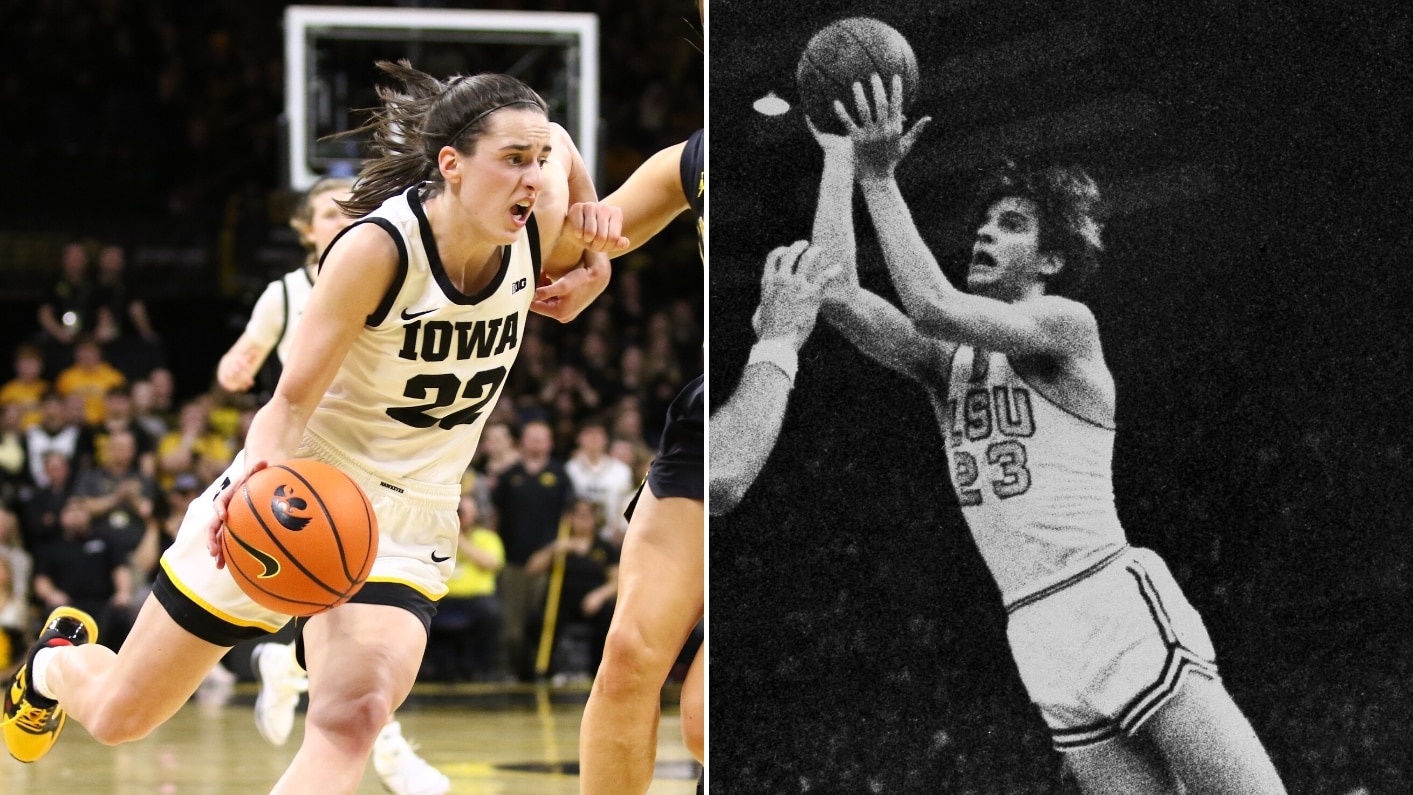Such was the magnetic, enduring power of Pete Maravich and his endless array of trick shots, dribble fakes and pinpoint passes. Here was a hardwood ghost, who died 14 years before Clark was born, deserving of careful study. Here was a savant whose improvisational skills reappear in flashes when the 22-year-old guard leads Iowa’s breakneck attack.
As Clark closes in on Maravich’s NCAA career scoring record of 3,667 points, needing 18 points to surpass it and her next game scheduled for Sunday against Ohio State, the first impulse might be to draw distinctions. Beyond gender, Maravich starred at LSU from 1967 to 1970, when college basketball didn’t have a shot clock or a three-point line and when many SEC teams were not racially integrated. Maravich, who averaged 44.2 points across three seasons, wasn’t allowed to play on the varsity team as a freshman; Clark, a senior averaging 28.3 points during her career, is eligible to play a fifth year next season because of the NCAA’s coronavirus regulations.
Those fundamental differences led one of Maravich’s sons to tell Yahoo Sports that Maravich and Clark make for an “apples-to-oranges comparison.” But to cast these stars as oppositional forces would be to miss the point of their shared genius. There’s a much more apt culinary reference: two peas in a pod.
“I would like to be remembered as a person who played the game from one standpoint: to entertain the fans,” Maravich said. “We’re here only for a short period of time, and I think it’s very important we touch as many people as we can.”
Similarly, showmanship and connectivity have been hallmarks of Clark’s college career, which has seen her guide top-five offenses for four straight seasons, lead a run to last year’s NCAA title game, surpass Kelsey Plum as the NCAA’s leading women’s scorer, eclipse Lynette Woodard as the all-time leading women’s scorer, and delight a ravenous fan base in her home state.
“I love winning, and that’s really fun,” Clark said shortly before her 2023 March Madness run. “People love to watch us win. But I’ve been able to see the amount of joy I’ve been able to put on people’s faces and change some of their lives. That’s been the coolest thing to me.”
Maravich conjured open-court magic before Magic Johnson, and the “Showtime” maestro wasn’t shy about admitting he stole one of Pistol Pete’s signature passes: freezing the defense by moving his hand in a circular feint before quickly batting the bouncing ball with an open palm to a fast-breaking teammate. Though Maravich was a master of fundamentals, he shredded the textbook and left no angle unexplored, tossing underhand hit-ahead passes, no-look dimes to cutters and 50-foot bounce passes. The statue that honors him in Baton Rouge depicts Maravich tossing a behind-the-back pass, the bronze ball set to delicately roll off his fingertips.
Playing for his father at LSU, Maravich enjoyed the greenest light any college player has ever seen. He averaged nearly 40 shots as a sophomore, scored a then-record 69 points against Alabama in 1970 and averaged more than a point per minute for his career. Last year, Antoine Davis fell four points shy of passing Maravich’s career mark — even though the Detroit Mercy guard averaged 25.4 points per game across five seasons.
Maravich’s three seasons account for the three highest-scoring averages in NCAA history, and his astonishing 44.5 points per game as a senior in 1969-70 should be regarded as one of the sport’s most unbreakable records. Denver’s Tommy Bruner averages 25.1 points to lead the nation this year, and no NCAA Division I men’s player has averaged more than 31 points since 1991. Absent dramatic changes to the game’s length, shot clock, fundamental strategies or scoring rules — A four-point line? A five-point line? — Maravich’s points-per-game mark should stand for decades to come.
For those too young to have seen Maravich for themselves, the YouTube videos that once caught Clark’s attention hold up remarkably well more than a half-century later. In clip after clip, he buries smooth jumpers from all over the court, dribbles circles around overmatched defenders with both hands and carries himself with a confidence that led to swelling crowds.
While her deep three-point shooting range is constantly compared to Stephen Curry’s, many of Clark’s most impressive plays make her look like Maravich’s spitting image. She launches quick-attack fast breaks with audacious outlet passes, threads bounce passes through traffic and targets post players with fastballs that whiz right past opponents’ ears.
Entire buildings lean forward in anticipation when Clark crosses half court with a full head of steam. As obstacles emerge, she weaves through them seemingly without a plan before easy baskets, for herself or a teammate, emerge as if from thin air. Like Maravich, she hits difficult shots and stuffs the box score so reliably that fans drive from hours away to experience a national phenomenon for themselves.
In some cases, the parallels between Maravich and Clark, who each claimed player of the year honors and multiple NCAA single-season scoring titles, are eerie. When Maravich passed Oscar Robertson to claim the NCAA’s scoring record in 1970, he swished a jumper and was lifted off the court by his teammates. When Clark eclipsed Plum on Feb. 15, she swished a jumper and, sure enough, was lifted off the court by her teammates. As photographers swarmed the jubilant and chaotic scenes, Maravich and Clark looked uneasy while held aloft and relieved once returned to the ground.
A closer inspection of the milestone moments revealed differences so slight they only further entwined the two stars. Maravich went off for 53 points on his record-setting night; Clark finished with a career-high 49 after passing Plum in a win over Michigan. Both wore home white uniforms, with Maravich’s No. 23 just one digit off Clark’s No. 22. The LSU Coliseum’s fans shouted “One more, one more!” as Maravich approached Robertson’s mark, while the Carver-Hawkeye Arena crowd chanted “One more year, one more year!” to encourage Clark to delay the start of her WNBA career.
After leaving LSU, Maravich became a five-time NBA all-star and a Basketball Hall of Famer, but career-altering injuries and a relative lack of postseason success prevented him from being viewed as one of the league’s all-time greats. While overlooked at times, Maravich, who died of sudden cardiac death at 40 in 1988, hasn’t been forgotten. He was selected as a member of the NBA’s 50th (1996) and 75th anniversary (2022) teams, and Clark’s teenage discovery of his oeuvre is proof that his legend lives on, passed down from thrilled generation to thrilled generation.
Clark’s chase of Woodard’s AIAW-best 3,649 points was an excellent opportunity to celebrate the former Kansas star, whose scoring prowess remains unrecognized by the NCAA. In the same vein, Clark’s imminent passing of Maravich shouldn’t be viewed as an act of displacement or erasure.
Instead, just picture the timeless Tiger tossing one of his many records behind his back to a studious and worthy heir.


 Best Underground Water Leak Detection Equipment 2024
Best Underground Water Leak Detection Equipment 2024  Best Backyard Ideas: Turn Your Outdoor Area Into a Creative and Calm Haven
Best Backyard Ideas: Turn Your Outdoor Area Into a Creative and Calm Haven  Babar, Rizwan are good players but not whole team, says Mohammad Hafeez
Babar, Rizwan are good players but not whole team, says Mohammad Hafeez  Pak vs NZ: Green Shirts aim to bounce back against Kiwis today
Pak vs NZ: Green Shirts aim to bounce back against Kiwis today